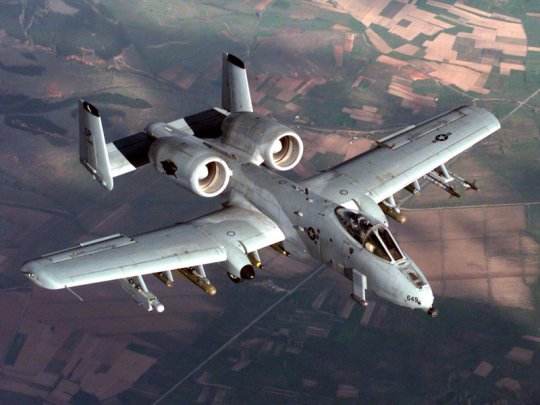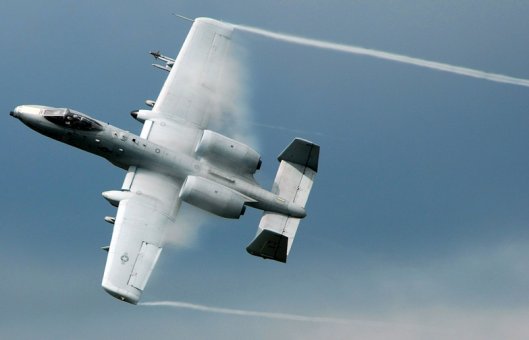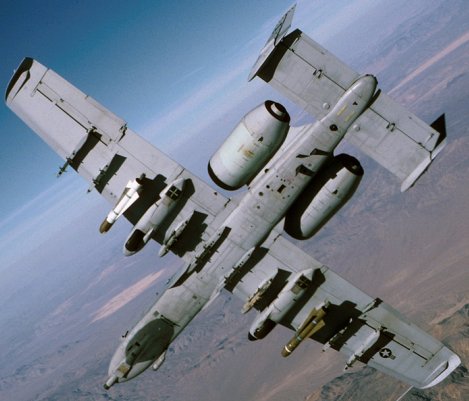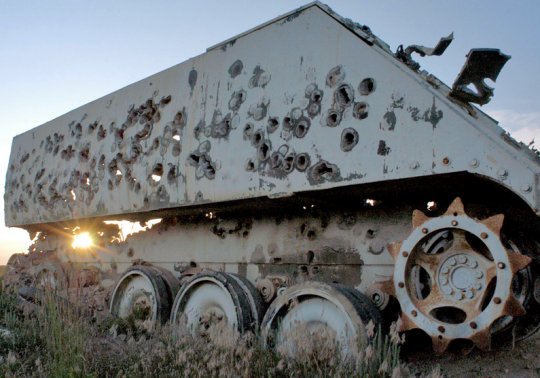
A/OA-10/A Thunderbolt II
Primary function: A-10, close-air support; OA-10, airborne forward air control. Speed: 420 mph. Dimensions: Wingspan 57 ft. 6 in.; length 53 ft. 4 in.; height 14 ft. 8 in. Range: 800 miles. Armament: 30 mm seven-barrel Gatling gun; up to 16,000 pounds of mixed ordnance, including 500 pound Mk-82 and 2,000 pound Mk-84 series low/high drag bombs, incendiary cluster bombs, combined effects munitions, mine dispensing munitions, AGM-65 Maverick missiles and laser-guided/electro-optically guided bombs; infrared countermeasure flares; electronic countermeasure chaff; jammer pods; 2.75-inch rockets; illumination flares and AIM-9 Sidewinder missiles. Crew: One. Inventory: A-10, 129 and OA-10, 75; Guard, A-10, 76 and OA-10, 26; Reserve, A-10, 44 and OA-10, seven



by Staff Sgt. Markus Maier
U.S. Central Command Air Forces Combat Correspondent Team
AFPN
AL ASAD AIR BASE, IRAQ
A new version of the A-10 Thunderbolt II has been flying over Iraq providing close-air support for the ground troops from Al Asad Air Base for nearly two months.
As part of the Precision Engagement Upgrade Program, the Maryland Air National Guard’s 175th Wing has been converting it’s A-10s from A to C models.
“We are the first A-10C model squadron to deploy to combat,” said Lt. Col. Timothy Smith, the 104th Expeditionary Fighter Squadron commander. “We just transitioned to the aircraft six months prior to coming here, and the C-model was officially declared combat ready just two weeks before we deployed. I am very proud of our unit. We’ve put in a monumental effort, as individuals and as a group to get to this point.”
The A-10C might look the same on the outside, but the recent upgrades have turned the aircraft, which was originally designed to battle Russian tanks during the Cold War, into an even more lethal and precise close-air-support weapons system.
A few of the key upgrades are a “first ever” for the aircraft, said Capt. Rich Hunt, a 104th EFS A-10C pilot. One of them is the situational awareness data link.
“Previously, for me to keep track of all the other airplanes that are around me or to help us perform the mission, I would literally have to write those down with a grease pencil inside my canopy or write them down on a white piece of paper on my knee board in order to keep track of all that,” Captain Hunt said. “Now I have a color display that has all of the other airplanes that are up supporting the same mission across all of Iraq right now. And they are all digitally displayed through that data link on my map. So now, especially at night when awareness is a little bit lower, I can look at that beautiful map display and know exactly what other airplanes are around me.”
The new system also provides the pilot with other critical information, such as what the other airplanes might be targeting, what munitions they have on board and fuel levels.
“That awareness provides us with a ton of valuable information in a very user-friendly manner,” the captain said. “(It allows us) to do our mission with a lot clearer understanding of exactly what is going on around us in the battle space and what our wingmen may be targeting.”
Another vital feature the data link offers is secure communication.
“All of the data that goes across that data link display is secure,” he said. “Using that data link, I can also text message. We use that in more of a command and control situation. For example, if we are flying a mission hundreds of miles away and our operations desk here gets information through the classified computer network of a mission that we may have to support, they can text message right to my airplane — and only to my airplane — and tell me exactly what I need to know.”
Something else the new C-model provides to the pilots is the integration of advanced targeting pods, which have also been upgraded. The new pods include long-range TV and infrared cameras with zoom capabilities and a laser target designator.
“Primarily, we still use the pods for weapons strikes,” Captain Hunt said. “However, in Iraq we find ourselves supporting the troops on the ground by doing a lot of counter improvised explosive devices missions.”
The pods infrared capability can be used to detect buried IEDs by picking up on their heat signature.
The new targeting pods have also been outfitted with the ROVER downlink capability, allowing the aircraft to transmit the live video feed to a joint terminal attack controller on the ground. This allows for more precise strikes with less chance of a chance for collateral damage.
“In Iraq that is especially important because it’s a very difficult situation when we provide close-air support in such a densely urban environment,” the captain said. “By the controller being able to look through my targeting pod real time, we can compare exactly what we are looking at and make sure we have an absolutely 100 percent positive identification of the target.”
Another upgrade that increases the A-10’s precision is that it can now employ the Global Positioning System-guided joint direct attack munitions.
“Sometimes we find ourselves where we have to destroy a terrorist stronghold location. But in the house across the street are friendly Iraqi civilians,” Captain Hunt said. “We know we have to destroy the stronghold, but we don’t want to cause any collateral damage whatsoever. So the JDAM has been outstanding for us. We’ve had unbelievable success where we’ve been able to strike the stronghold without causing any damage to the houses around it.
“Between the situational awareness data link, the targeting pod with the ROVER down link to the controller on the ground and the JDAM, the A-10C on this deployment has been an amazing success for us,” the captain said.
The A-10 has been around the Air Force since the 1970s and with these new upgrades will remain well into the future.
“As technology moved further ahead, we stayed pretty far behind,” Colonel Smith said. “And now, all over sudden, we have leapfrogged all the way pretty much to the front edge of all the technology for everybody.”
But the colonel also said while they are the first unit to fly the C-model in combat, their main focus is not on the upgrades.
“In our minds we are just flying like we normally do,” Colonel Smith said. “We don’t see ourselves as the first A-10C model in combat, we see ourselves as A-10 pilots out helping the guy on the ground. I have great respect for the men and women on the ground. They are the ones who are really putting their lives on the line when they are out there. Our job is to ride shotgun for them — to sit there in position, and ready for them when they need us. And now we have more tools available to do it faster and more precisely.”

Wild Thing’s comment……..
How’s that saying go…Don’t bother running, you’ll just die tired!
This is a great video…….A-10 “Warthogs from hell”

WT… you’re making me homesick with the A-10 Thunderbolt support mission at MBAFB on the Grand Strand in 1978 and 1979 and 1980! And Alabama rocked the Bowery as well. Go Gamecocks, Tigers and Chanticleers!
And the Air Force almost retired the A-10 just before the 1st Gulf War. Then it was discovered what a great ground attack aircraft this was, just as designed. The ground troops loved it. It carried lots of ordnance, had a decent loiter time and was very accurate with it’s weapons system.
The A-10 should be around for a long time.
I looove the A-10! Kicks *ss!
Although kick ass, those A-10’s are sooooo slow. We used to hate dragging them across the pond during deployments. Our KC-135’s had to fly at just about stall speed in order to in-flight refuel them
I have always said since I saw the first one that when and if I could come back. I’d want to be an A-10 pilot.
Love ’em, “we see ourselves as A-10 pilots out helping the guy on the ground “, no statement is more true. In every war the grunt on the ground is the poor slob that’s engaged in the eyeball to eyeball contact with the enemy. Thank god there are the A-10 and chopper pilots that are there to get them off the troops backs.
The Warthog. Beautiful, in its own way.
Darth giggle glad you liked it.
Tom thanks for sharing that. I hope they are around for a long time.
Patrick they do kiss ass. hahaha Love it too.
Bob thanks for sharing about your experiences with them.
Mark, they are neat for sure. I love all they can do.
Jack that is great, thanks for sharing about that.
Cousin Dave it sure is, there is a real beauty to it. I love things like this.